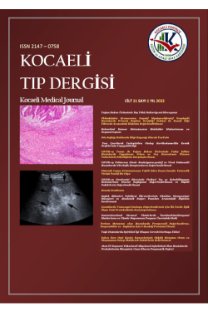Investigation of The Effects of Electromagnetic Fields on Serum Paraoxonase (PON1)
Serum Paraoksonaz (PON1) Üzerine Elektromanyetik Alanların Etkisinin Araştırılması
___
1. Morabito C, Steimberg N, Rovetta F, Boniotti J, Guarnieri S, Mazzoleni G, et al. Extremely lowfrequency electromagnetic fields affect myogenic processes in C2C12 myoblasts: role of gapjunction-mediated intercellular communication. BioMed Res Int. 2017;2017:2460215.2. Wdowiak A, Mazurek PA, Wdowiak A, Bojar I. Effect of electromagnetic waves on human reproduction. Ann Agric Environ Med. 2017;24(1):13-18.
3. Khaki AA, Zarrintan S, Khaki A, Zahedi A. The effects of electromagnetic field on the microstructure of seminal vesicles in rat: a light and transmission electron microscope study. Pak J Biol Sci. 2008;11(5):692-701.
4. Wang H. and Zhang X. Magnetic fields and reactive oxygen species, Int J Mol Sci. 2017;18(10):2175.
5. Poprac P, Jomova K, Simunkova M, Kollar V, Rhodes CJ, Valko M. Targeting free radicals in oxidative stress-related human diseases. Trends Pharmacol Sci. 2017;38(7):592-607
6. Seifirad S, Farzampour S, Nourbakhsh M, et al. ELF-EMF on PON1 serum activity and lipid peroxidation metabolites in rat. J Diabetes Metab Disord. 2014;13:85.
7. Kowalska K, Socha E and Milnerocwicz H. The role of paraoxonase in cardiovascular diseases. Ann Clin Lab Sci. 2015;45(2):226-233.
8. Litvinov D, Mahini H. and Garelnabi M. Antioxidant and anti-inflammatory role of PON1: implication in arteriosclerosis diseases. N Am J Med Sci. 2012;4(11):523–532.
9. Memişoğulları R. and Orhan N. Paraoxonase and cancer, e-ISSN1309-3878 Konuralp Medical Journal. 2010;2(2):22-26.
10. Ferré N, Camps J, Prats E, Vilella E, Paul A, Figuera L, et al. Serum Paraoxonase activity: a new additional test for the improved evaluation of chronic liver damage. Clin Chem. 2002;48(2):261- 268.
11. Wolf FI, Torsello A, Tedesco B, et al. 50-Hz extremely low frequency electromagnetic fields enhance cell proliferation and DNA damage: possible involvement of a redox mechanism. Biochim Biophys Acta. 2005;1743(1-2):120-129.
12. Focke F, Schuermann D, Kuster N, et al. DNA fragmentation in human fibroblasts under extremely low frequency electromagnetic field exposure. Mutat Res. 2010;683(1-2):74-83.
13. Tiwari R, Lakshmi NK, Bhargava SC, & Ahuja YR. Epinephrine, DNA integrity and oxidative stress in workers exposed to extremely low-frequency electromagnetic fields (ELF-EMFs) at 132 kV substations. Electromagn Biol Med. 2015;34(1):56-62.
14. Selek S, Coşar N, Koçyiğit A. et al. PON1 activity and total axidant status in patients with active pulmonary tuberculosis. Clin Chem. 2008;41:140-144.
15. Aslan M, Nazligul Y, Horoz M, et al. Serum paraoxonase-1 activity in Helicobacter pylori infected subjects. Atherosclerosis. 2008;196:270- 274.
16. Abdi S. Effects of static and electromagnetic fields on human serum paraoxonase-1 activity in vitro. J Bas Res Med Sci 2018;5(2):21-26.
17. Çelik MS, Akpolat V, Işık B, Çelik MY, Yavaş MC. et al. ELF-EMF on serum PON1 and MDA levels, Int Arch Med. 2014;6(1):1-4.
18. Korkmaz İ. et al. The relationship between oxidative stress, paraoxanase and injury severity in blunt trauma patients, J Clin Anal Med. 2013;4(3):196-9.
19. Aggarwal G. et al. Toward understanding the catalytic mechanism of human paraoxonase 1: sitespecific mutagenesis at position 192. PLoS ONE. 2016;11(2).
20. Bodolay E, Seres I, Szodoray P, et al. Evaluation of paraoxonase activity in patients with mixed connective tissue disease. J Rheumatol. 2008;35:237-43.
21. Erdem FH, Karatay S, Yıldırım K, et al. Evaluation of serum paraoxonase and arylesterase activities in ankylosing spondylitis patients. Clinics (Sao Paulo). 2010;65:175-9.
22. Çakir DU, Yokuş B, Akdağ MZ. et al. Alterations of hematological variations in rats exposed to extremely low frequency magnetic fields (50 Hz), Arch Med Res. 2009;4:352-356.
23. Kıvrak EG, Yurt KB, Kaplan AH. et al. Effects of electromagnetic fields exposure on the antioxidant defense system. Journal of Microscopy and Ultrastructure. 2017;5(4):167-176.
24. Kiray A, Tayefi H, Kiray M, et al. The effects of exposure to electromagnetic field on rat myocardium. Toxicol Ind Health. 2013; 29: 418- 425.
25. Koylu O, Gürbilek M, Çiçekbaşı AE, et al. The effects of electromagnetic fields on the level of MDA that’s known as A carsinogenic compound, in the rats’ brain tissue and plasma. Journal of Turkish Clinical Biochemistry. 2005;3(1):027-033.
26. Akdağ MZ, Dasdağ S, Akşen F. et al. Effect of ELF magnetic fields on lipid peroxidation, sperm count, p53, and trace elements. Med Sci Monit. 2006;12(11):366-371.
27. Akdag MZ, Dasdag S, Ulukaya E, et al. Effects of extremely low-frequency magnetic field on caspase activities and oxidative stress values in rat brain. Biol Trace Elem Res. 2010;138:238-249
- ISSN: 2147-0758
- Yayın Aralığı: 3
- Başlangıç: 2012
- Yayıncı: -
Periton Diyalizi Hastalarında Optik Koherens Tomografi Ölçümlerinin Değerlendirilmesi
Adnan BATMAN, Büşra YILMAZ TUĞAN, Necmi EREN, Serkan BAKIRDÖĞEN, Sibel BEK
Bir Olgu Sunumu: Matür Kistik Over Teratomu
Ayşegül PALA, Aybars ÖZKAN, Öner ÖZDEMİR, Olena ERKUN
Post-discharge Feedback Evaluation of Patients who Have Received Health Care in Orthopedic Surgery
Sevda UZUN DIRVAR, Ferdi DİRVAR, Mehmet Akif KAYGUSUZ
Neslihan GÖKCEN, Esra KAYACAN ERDOĞAN, Suade Özlem BADAK, Süleyman ÖZBEK
Investigation of The Effects of Electromagnetic Fields on Serum Paraoxonase (PON1)
Mehmet Cihan YAVAŞ, Mehmet Zülküf AKDAĞ, İbrahim KAPLAN, Mustafa Salih ÇELİK
Kalıtsal Trombofilili Gebelerin Obstetrik ve Neonatal Sonuçları
Özlem ERTEN, Aysun TEKELİ TAŞKÖMÜR
DMSA taraması: Tekrarlayan İdrar Yolu Enfeksiyonu Olan Çocuklarda Başlangıç Tetkiki Olabilir mi?
Ahmet Anıl ŞAHİN, Ömer TAŞBULAK
Mehmet Akif KAYGUSUZ, Ferdi DİRVAR, Sevda UZUN DIRVAR
Kadınlarda Primer Spontan Pnömotoraks Katamenial İlişikisininDeğerlendirilmesi
Sadi KAYA, Koray AYDOĞDU, Yücel YÜZBAŞIOĞLU, Şevki Mustafa DEMİRÖZ, Funda İNCEKARA, Göktürk FINDIK, İlteriş TÜRK
